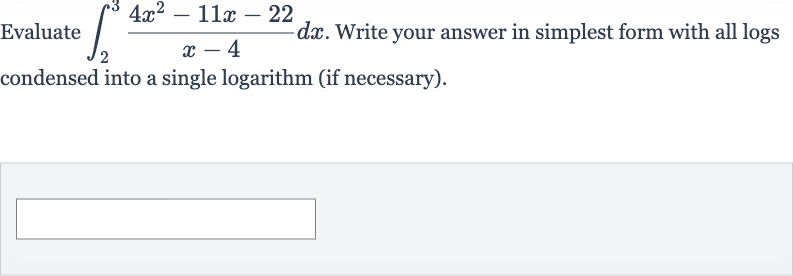Full solution
Q. Evaluate . Write your answer in simplest form with all logs condensed into a single logarithm (if necessary).
- Perform Long Division: First, we need to perform polynomial long division to simplify the integrand . This will allow us to integrate the function more easily.
- Simplify Numerator: Performing the long division, we divide by to get . Multiplying by gives us . We subtract this from the original numerator to get a new numerator of .
- Integrate Each Term: Continuing the long division, we divide by to get . Multiplying by gives us . We subtract this from the new numerator to get a remainder of .
- Evaluate Definite Integral: The result of the long division is that simplifies to . Now we can integrate each term separately.
- Calculate Values: The integral of with respect to is , the integral of with respect to is , and the integral of with respect to is . So the integral of our function from to is the integral of from to .
- Sum Up Results: We evaluate the definite integral by calculating the antiderivative at the upper limit and subtracting the antiderivative at the lower limit. For , we get . For , we get . For , we get .
- Sum Up Results: We evaluate the definite integral by calculating the antiderivative at the upper limit and subtracting the antiderivative at the lower limit. For , we get . For , we get . For , we get .Calculating the values, we get for the first term, which is . For the second term, we get . For the third term, we get , which simplifies to since the absolute value of a negative number is positive and is .
- Sum Up Results: We evaluate the definite integral by calculating the antiderivative at the upper limit and subtracting the antiderivative at the lower limit. For , we get . For , we get . For , we get .Calculating the values, we get for the first term, which is . For the second term, we get . For the third term, we get , which simplifies to since the absolute value of a negative number is positive and is .Adding up the values, we get . This simplifies to , which is .

